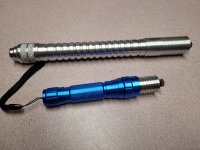Just finished my second assembly. Not really sure i can call it an "assembly" or "build", since most of the work was done by others - I just soldered the module into the host and tightened a screw 
Either way, here they are:

Smaller one is a PLTB450B 1.6w 450nm. I did that one first before messing with the big one. That's a NUBM44. Both ordered from DTR's Laser Shop and both hosts from @Lifetime17 - (thank you for the guidance, too!)
I don't know how to safely take pictures of them in action - I'm concerned they might blow out my phone camera without some sort of protection for the lens.
Either one can light a match pretty easily. I got a couple good lessons in how much power these things have though, when I was trying to focus the 1.6W one on a dining room chair and started noticing some smoke forming! The big one did the same to the deck rail when I was focusing it too (not unexpectedly that time, but faster than expected). I think I need to figure out better focusing targets.
I'm wondering about the beam spread, though. I can get it pretty tight up fairly close. As the distance increases it starts getting more rectangular. If I'm understanding right, it's because these are actually a number of diodes set in a line to get the intensity? What I'm NOT understanding is how those lasers you see on the videos popping balloons and lighting matches across a room keep such a tight beam.
I guess next step for me will be building my own driver. Need to get more tools before I can get into any sort of host fabrication...
Either way, here they are:

Smaller one is a PLTB450B 1.6w 450nm. I did that one first before messing with the big one. That's a NUBM44. Both ordered from DTR's Laser Shop and both hosts from @Lifetime17 - (thank you for the guidance, too!)
I don't know how to safely take pictures of them in action - I'm concerned they might blow out my phone camera without some sort of protection for the lens.
Either one can light a match pretty easily. I got a couple good lessons in how much power these things have though, when I was trying to focus the 1.6W one on a dining room chair and started noticing some smoke forming! The big one did the same to the deck rail when I was focusing it too (not unexpectedly that time, but faster than expected). I think I need to figure out better focusing targets.
I'm wondering about the beam spread, though. I can get it pretty tight up fairly close. As the distance increases it starts getting more rectangular. If I'm understanding right, it's because these are actually a number of diodes set in a line to get the intensity? What I'm NOT understanding is how those lasers you see on the videos popping balloons and lighting matches across a room keep such a tight beam.
I guess next step for me will be building my own driver. Need to get more tools before I can get into any sort of host fabrication...



